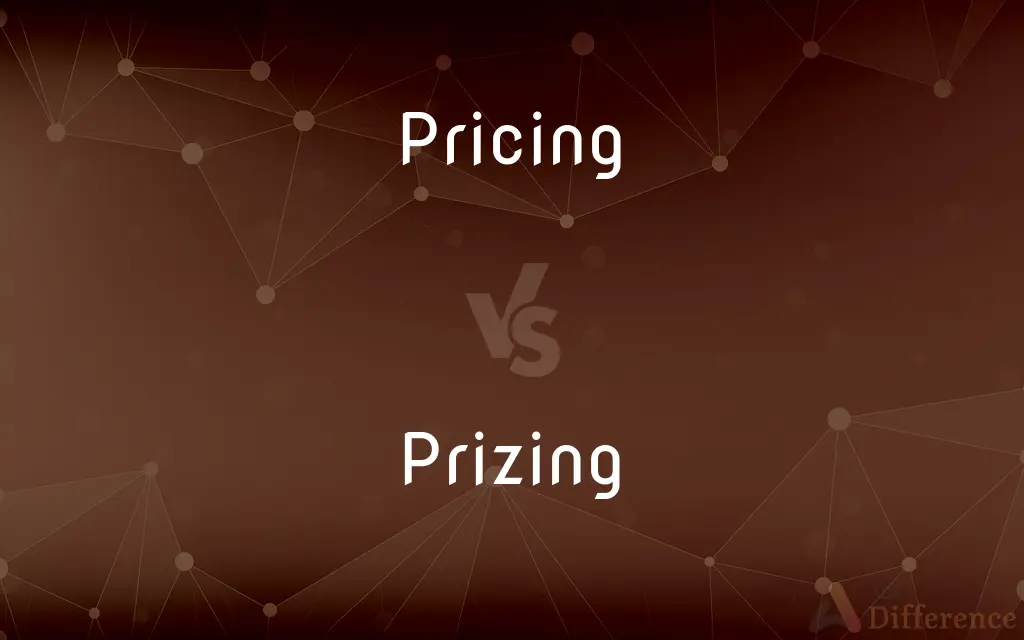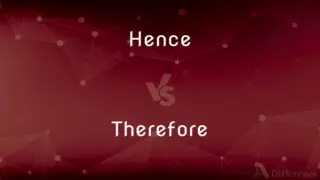Pricing vs. Prizing — What's the Difference?
By Urooj Arif & Fiza Rafique — Updated on April 21, 2024
Pricing involves determining the cost of goods or services, focusing on market factors and production costs; prizing refers to the act of valuing or awarding something as a reward.

Difference Between Pricing and Prizing
Table of Contents
ADVERTISEMENT
Key Differences
Pricing is a critical business function that involves setting the value for products or services offered to consumers, often based on factors like cost, market demand, and competitive positioning. In contrast, prizing generally means giving an award or honor, often used in contexts of competitions or achievements.
In terms of consumer interaction, pricing can directly influence buying behavior by making an item more or less attractive based on its cost. Whereas prizing is typically used to recognize excellence or to motivate participants in various contexts, such as games or contests.
Pricing strategies can be complex, involving psychological pricing, discount pricing, premium pricing, and more, each tailored to maximize profit or market share. On the other hand, prizing is usually simpler, focusing on the symbolic value of the award rather than its economic implications.
Companies spend considerable effort in researching and developing effective pricing models to ensure profitability. Meanwhile, organizations that focus on prizing are more concerned with the selection criteria and the perceived value of the prizes to enhance prestige or promote engagement.
While pricing must adapt to changes in the market environment, such as inflation or shifts in consumer preferences, prizing tends to remain more consistent, anchored in the traditions or rules established by the awarding body.
ADVERTISEMENT
Comparison Chart
Definition
Setting a price for goods/services.
Awarding something as a reward.
Primary Context
Business and commerce.
Competitions and recognitions.
Impact
Affects consumer buying decisions.
Motivates and recognizes merit.
Complexity
Involves various strategies.
Generally straightforward.
Dependency
Influenced by market changes.
More consistent and stable.
Compare with Definitions
Pricing
Profit calculation.
Proper pricing ensures that the company maintains a profit margin.
Prizing
Awarding excellence.
Prizing the best performers boosts motivation in the company.
Pricing
Competitive tool.
Competitive pricing helps to attract customers away from competitors.
Prizing
Symbol of achievement.
Prizing in sports often involves trophies and medals.
Pricing
Setting a cost.
The store is pricing all new arrivals at a 20% discount.
Prizing
Recognition tool.
The festival ended with prizing the most innovative filmmakers.
Pricing
Psychological aspect.
Pricing products at $0.99 instead of $1.00 can increase sales.
Prizing
Motivational strategy.
Prizing students for good behavior can improve classroom dynamics.
Pricing
Market strategy.
Dynamic pricing allows fluctuation based on demand and supply.
Prizing
Celebration of talent.
The annual music awards focus on prizing outstanding artists.
Pricing
Pricing is the process whereby a business sets the price at which it will sell its products and services, and may be part of the business's marketing plan. In setting prices, the business will take into account the price at which it could acquire the goods, the manufacturing cost, the marketplace, competition, market condition, brand, and quality of product.
Prizing
Something offered or won as an award for superiority or victory, as in a contest or competition.
Pricing
The amount as of money or goods, asked for or given in exchange for something else.
Prizing
Something offered or won in a lottery or similar game of chance.
Pricing
The cost at which something is obtained
Believes that the price of success is hard work.
Prizing
Something worth striving for; a highly desirable possession.
Pricing
The cost of bribing someone
Maintained that every person has a price.
Prizing
Chiefly Southern US Something used as a lever or for prying.
Pricing
A reward offered for the capture or killing of a person
A felon with a price on his head.
Prizing
Offered or given as a prize
A prize cup.
Pricing
(Archaic) Value or worth.
Prizing
Given a prize, or likely to win a prize
A prize cow.
Pricing
To fix or establish a price for
Shoes that are priced at sixty dollars.
Prizing
Worthy of a prize; first-class
Our prize azaleas.
Pricing
To find out the price of
Spent the day pricing dresses.
Prizing
To value highly; esteem or treasure.
Pricing
Present participle of price
Prizing
To estimate the worth of; evaluate.
Pricing
The act of setting a price.
Prizing
To move or force with a lever; pry
Prized open the antique chest.
Pricing
The level at which a price is set.
Prizing
Present participle of prize
Pricing
The evaluation of something in terms of its price
Prizing
(obsolete) prizefighting abbreviation
Prizing
(philosophy) The act or state of prizing something, valuing it highly.
Common Curiosities
Can pricing be used as a competitive advantage?
Yes, effective pricing strategies can serve as a competitive advantage by attracting more customers, optimizing profit margins, and differentiating products in the marketplace.
What is the purpose of pricing?
The purpose of pricing is to determine the amount customers are willing to pay for a product or service, ensuring that sales are maximized and the business remains profitable.
How do companies determine prices?
Companies determine prices based on cost analysis, market demand, competitor pricing, and overall business strategy, often using tools like market research and pricing models.
In what contexts is prizing used?
Prizing is commonly used in educational, sports, business, and artistic contexts to motivate performance, acknowledge excellence, and encourage competition.
How does pricing affect consumer behavior?
Pricing directly impacts consumer purchasing decisions by making a product more or less appealing based on its perceived value compared to its price.
What are the key differences in strategy between pricing and prizing?
Pricing strategies are primarily economic and market-driven, aimed at maximizing profitability; prizing strategies are recognition-focused, aimed at celebrating success and encouraging specific behaviors.
What is the impact of prizing on recipients?
Prizing can significantly boost morale, motivation, and loyalty among recipients, often leading to increased productivity and engagement in their respective fields.
What are some common pricing strategies?
Common pricing strategies include cost-plus pricing, competitive pricing, value-based pricing, penetration pricing, and dynamic pricing.
Can prizing affect organizational culture?
Yes, prizing can positively influence organizational culture by promoting a sense of achievement, recognition, and competitiveness, enhancing overall morale and teamwork.
Are there ethical considerations in both pricing and prizing?
Yes, ethical considerations in pricing include fairness, transparency, and avoiding price gouging. In prizing, ethics involve impartiality, transparency, and the meaningfulness of the awards.
How do organizations choose what to prize?
Organizations set specific criteria based on desired outcomes, such as innovation, performance, or creativity, and select judges or systems to ensure fair and effective prizing.
How do market changes affect pricing and prizing differently?
Market changes can lead to adjustments in pricing strategies to remain competitive or profitable, while prizing generally remains consistent, though the value or type of prizes may adapt to changing cultural or industry standards.
How do pricing and prizing differ in their impact on behavior?
Pricing influences consumer buying behaviors, affecting decisions based on economic factors; prizing influences behavior through recognition and motivation, focusing on achievement and merit.
Which is more complex to implement effectively, pricing or prizing?
Pricing is generally more complex to implement effectively due to its direct impact on revenue and its sensitivity to external market and economic factors. Prizing, while simpler, requires careful consideration of the criteria and impact on recipients' morale and motivation.
Share Your Discovery

Previous Comparison
Hence vs. Therefore
Next Comparison
Spiced vs. SpicyAuthor Spotlight
Written by
Urooj ArifUrooj is a skilled content writer at Ask Difference, known for her exceptional ability to simplify complex topics into engaging and informative content. With a passion for research and a flair for clear, concise writing, she consistently delivers articles that resonate with our diverse audience.
Co-written by
Fiza RafiqueFiza Rafique is a skilled content writer at AskDifference.com, where she meticulously refines and enhances written pieces. Drawing from her vast editorial expertise, Fiza ensures clarity, accuracy, and precision in every article. Passionate about language, she continually seeks to elevate the quality of content for readers worldwide.













































